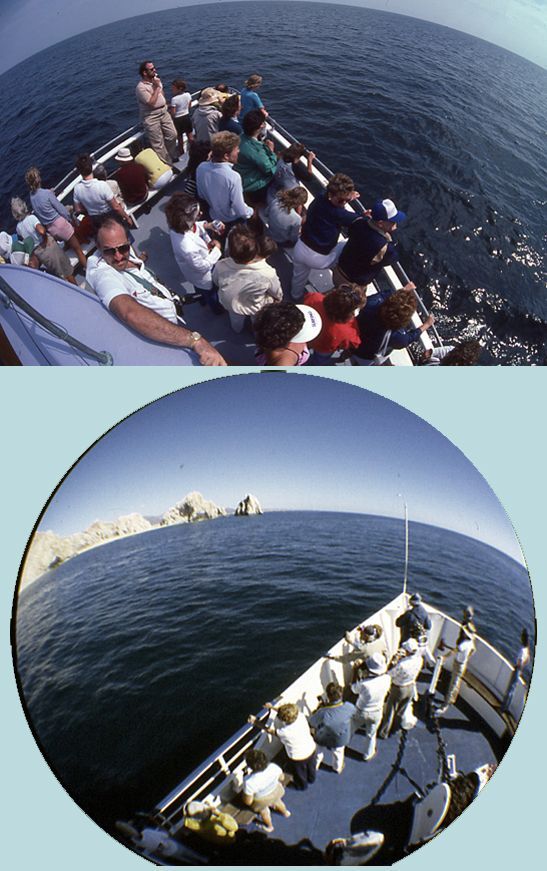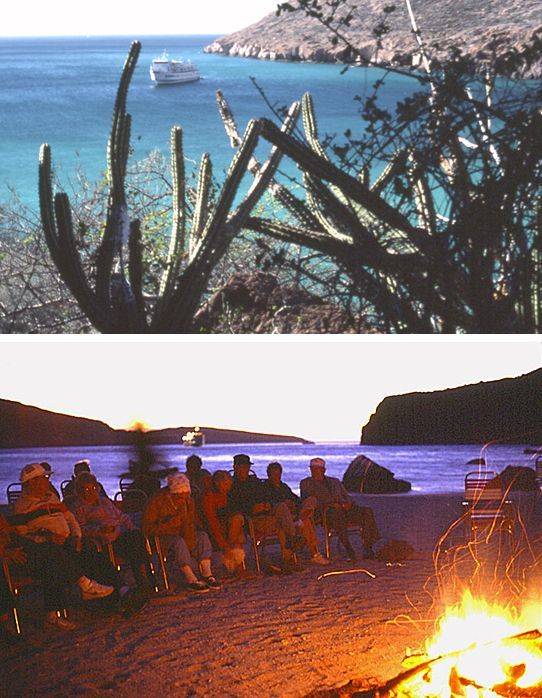Article
Baja California: Perhaps the Best Part of Mexico
Author(s):
The pristine simplicity of Baja, the best part of Mexico, is hard to resist. There is a reason why a small boat cruise into the Gulf of California, aka the Sea of Cortez, is on many persons' bucket lists.
Photography by the authors
If you’ve suffered a frozen winter in the United States, there’s one thing for sure about Mexico: it’s bound to be warm.
However, Mexico is at its best when things are kept simple. San Diego’s proximity to Mexico has given us our share of stories: from a car of young, male family members being held up at gunpoint in the middle of the night by brigands pretending to be police (they demanded and got money for allowing the Americans back into the United States) to responding to an invitation from the Secretary of Tourism to visit La Paz to interview him, only to find on arrival that he had gone fishing for a week.
So one approaches a Mexican vacation with some caution.
Yet the pristine simplicity of Baja — the best part of Mexico — is hard to resist. If you have gone through life a wild man or woman on a motorbike, you might consider tackling the Baja 1000 and if you are a keen fisherman like our relative, Chris Torre, maybe you can rent a 60-foot Hatteras and take off for Baja spaces unknown. Or, if you are sensible, you can look for a small boat cruise line that has been in Baja business for some time and book a cabin.
We went round Baja into the Gulf of California on the Pacific Northwest Explorer, a ship owned by Special Expeditions. That small ship is now used off the West Coast by an Oregon company, Travel Dream West, for cruises from San Francisco to Seattle, but there are still great choices for Baja. Lindblad Expeditions’ National Geographic Sea Bird and Sea Lion each hold 62 passengers and are perfect for poking into small bays and lagoons. The best value seems to be the previously-named American Safari Cruises, now calling itself InnerseaDiscoveries or Un-Cruise Adventures.
To compare cruises is complicated because different months and cabins have, of course, different prices. Passengers have to do their homework. The Californian Gray Whale season is mostly January to March, so you do have time to plan for this coming winter. Note sometimes cruises are offered for those with special interests, such as photographers.

You will see dolphins closer up than whales. Boy! Will you see dolphins.
What to expect
Don’t expect Silversea or Crystal Cruises’ elegance. The small ships are flat bottomed, some with a draft of only 7-and-a-half feet so they can get into the whale lagoons. Such shallow draft can make for a rocky cruise, particularly on the way back north.
There may be quite a bit of climbing into rubber boats to get among the whales and there will certainly be walking over rough terrain. Despite that, you will find a lot of elderly travelers among the passengers: a cruise through the Gulf of California (Sea of Cortez) is on many persons’ bucket lists.
Leaving from San Diego, you are off the San Benito Islands at dawn, high terrain that really represents the tops of the Sierra Vizcaino Mountains as they run out to sea. West Benito, rising to a single cone of 660 feet, is the largest of the 3 islands.

Expect warm weather and some hiking. You’ll find a village church in the square on West Benito Island and a doctor’s office.
We land on a sheltered cove with a steep gravel beach. We are heading for the north beach, says guide Ian McTaggart-Cowan, and its colonies of elephant seals that are always present from December to April with oystercatchers and Western gulls “parading the beach for any edibles.”

We come to a low escarpment that looks down on a gravel beach where a group of elephant seal cows have gathered to give birth to their black-furred pups.
We are far enough away not to be a threat to the monstrous beach-master bull seal who is repelling any challenging contender bulls with the trumpeting noises coming from his weird proboscis that he has inflated and tucked into his open mouth.
“If threat is not enough, an undulating charge will displace the intruder,” says McTaggart-Cowan.
It sure looks like it would displace us. We glance around uneasily.
Back on board, we venture on to a surprisingly placid sea. We first visit the San Ignacio Lagoon, one of the places where the whales come to calve. Our captain is meticulous at giving them space; even in the Humber rubber boats we let them keep their distance.

As always, the dolphins lead us along. They love to swim in the ship’s wake as if they are in competition with us.
We anchor outside the lagoon and stare at the towering waves sweeping over the sandbars and the gray whales moving by us into the lagoon. They all have their cargo of passengers.
“The gray whale is the most heavily parasitized of all the whales,” our guide says. “Notice the whale lice especially on the head around the blowholes and the barnacles on the older animals.”

Our small ship dances easily amongst the arches and into the harbor.
Cabo San Lucas brings us to the southernmost extremity of Baja California. Here, the waters of the Sea of Cortez meet the open Pacific. The capes reach several hundred feet before they plunge into the sea.

It takes time and effort to find Cabo so the beaches are not yet overwhelmed with tourists. Cabo in the 16th and 17th centuries was a favored harbor for pirates.
Beyond the pseudo-sophistication of Cabo San Lucas lie the spectacular Islas Espiritu Santo, Partida and Los Islotes.

Low cliffs of red rocks, brackish lagoons bordered with mangroves, stunted figs growing around water holes, brown bats coming to beach ponds in the late afternoon. The water is quite deep around Los Islotes so the captain brings us in close to study a colony of sea lions.
It’s like being kids again — and learning. Because of its geographical isolation and the harsh environment there are plants here that grow no other places on earth. Major coastal lowlands contrast with the sharply shaped landscapes of the central deserts. The southern part of the Baja peninsula lies partly within the tropics. It is essentially desert but every few years southern Baja is devastated by violent hurricanes called chubascos.

The captain has something else in mind for his passengers: a beach picnic around a campfire!
This is not your grandparents’ vacation for sure. But what memories it has given us — and one in particular:
A gray whale, a silhouette against the setting sun, swimming 100 feet ahead of our bow, blowing a 15-foot high jet of spray into the afternoon sky. The water vapor sparkling like Christmas lights in the rays of the sun. The snorting noise rolls across half a mile of ocean. The sea slides by. The whale moves on in its strange timeless voyage, its mysterious migration — a 14,000-mile roundtrip from its home in the Bering Sea to its breeding grounds in the lagoons of Baja California.
We had the late Dr. Robbins Barstow with us on that cruise, the cofounder of the Connecticut Cetacean Society, an internationally known figure in whale conservation. An elderly college professor, he was relaxing around the fire.
“We have seen on this very special cruise, Baja's Gentle Giants and Nature’s Great Parade,” he said.
He died in 2010 aged 91.
The Andersons, who live in San Diego, are the resident travel & cruise columnists for Physician's Money Digest. Nancy is a former nursing educator, Eric a retired MD. The one-time president of the NH Academy of Family Practice, Eric is the only physician in the Society of American Travel Writers. He has also written 5 books, the last called The Man Who Cried Orange: Stories from a Doctor's Life.




